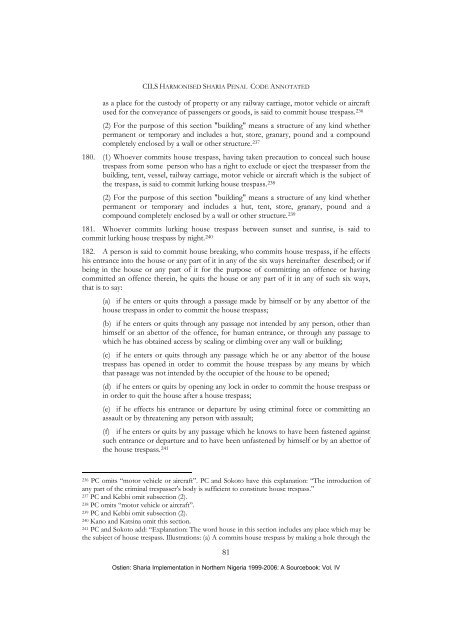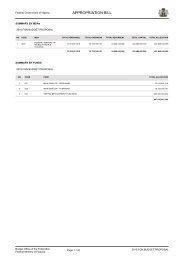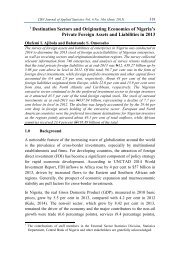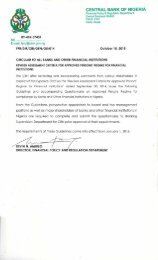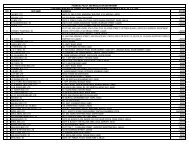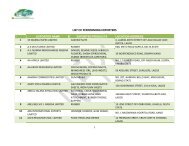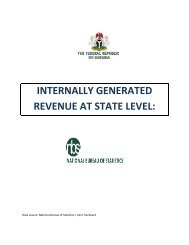vol_4_4_chapter_4_part_III
vol_4_4_chapter_4_part_III
vol_4_4_chapter_4_part_III
You also want an ePaper? Increase the reach of your titles
YUMPU automatically turns print PDFs into web optimized ePapers that Google loves.
CILS HARMONISED SHARIA PENAL CODE ANNOTATED<br />
as a place for the custody of property or any railway carriage, motor vehicle or aircraft<br />
used for the conveyance of passengers or goods, is said to commit house trespass. 236<br />
(2) For the purpose of this section "building" means a structure of any kind whether<br />
permanent or temporary and includes a hut, store, granary, pound and a compound<br />
completely enclosed by a wall or other structure. 237<br />
180. (1) Whoever commits house trespass, having taken precaution to conceal such house<br />
trespass from some person who has a right to exclude or eject the trespasser from the<br />
building, tent, vessel, railway carriage, motor vehicle or aircraft which is the subject of<br />
the trespass, is said to commit lurking house trespass. 238<br />
(2) For the purpose of this section "building" means a structure of any kind whether<br />
permanent or temporary and includes a hut, tent, store, granary, pound and a<br />
compound completely enclosed by a wall or other structure. 239<br />
181. Whoever commits lurking house trespass between sunset and sunrise, is said to<br />
commit lurking house trespass by night. 240<br />
182. A person is said to commit house breaking, who commits house trespass, if he effects<br />
his entrance into the house or any <strong>part</strong> of it in any of the six ways hereinafter described; or if<br />
being in the house or any <strong>part</strong> of it for the purpose of committing an offence or having<br />
committed an offence therein, he quits the house or any <strong>part</strong> of it in any of such six ways,<br />
that is to say:<br />
(a) if he enters or quits through a passage made by himself or by any abettor of the<br />
house trespass in order to commit the house trespass;<br />
(b) if he enters or quits through any passage not intended by any person, other than<br />
himself or an abettor of the offence, for human entrance, or through any passage to<br />
which he has obtained access by scaling or climbing over any wall or building;<br />
(c) if he enters or quits through any passage which he or any abettor of the house<br />
trespass has opened in order to commit the house trespass by any means by which<br />
that passage was not intended by the occupier of the house to be opened;<br />
(d) if he enters or quits by opening any lock in order to commit the house trespass or<br />
in order to quit the house after a house trespass;<br />
(e) if he effects his entrance or de<strong>part</strong>ure by using criminal force or committing an<br />
assault or by threatening any person with assault;<br />
(f) if he enters or quits by any passage which he knows to have been fastened against<br />
such entrance or de<strong>part</strong>ure and to have been unfastened by himself or by an abettor of<br />
the house trespass. 241<br />
236 PC omits “motor vehicle or aircraft”. PC and Sokoto have this explanation: “The introduction of<br />
any <strong>part</strong> of the criminal trespasser’s body is sufficient to constitute house trespass.”<br />
237 PC and Kebbi omit subsection (2).<br />
238 PC omits “motor vehicle or aircraft”.<br />
239 PC and Kebbi omit subsection (2).<br />
240 Kano and Katsina omit this section.<br />
241 PC and Sokoto add: “Explanation: The word house in this section includes any place which may be<br />
the subject of house trespass. Illustrations: (a) A commits house trespass by making a hole through the<br />
81


